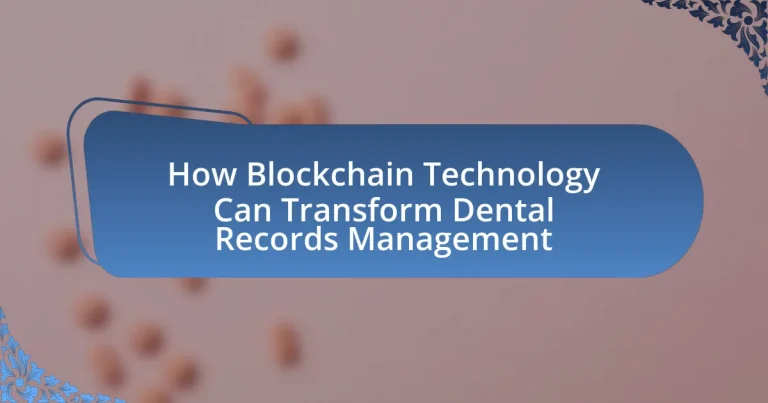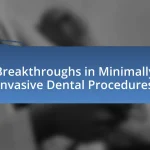Blockchain technology is a decentralized digital ledger that offers a secure and immutable method for managing dental records. This article explores how blockchain can enhance dental records management by improving data security, interoperability, and patient control over their information. Key features such as decentralization and cryptographic encryption are discussed, highlighting their role in safeguarding sensitive patient data and facilitating seamless sharing among dental professionals. Additionally, the article addresses current challenges in dental records management, including data security breaches and inefficiencies, while outlining the practical applications and future trends of blockchain in this field.
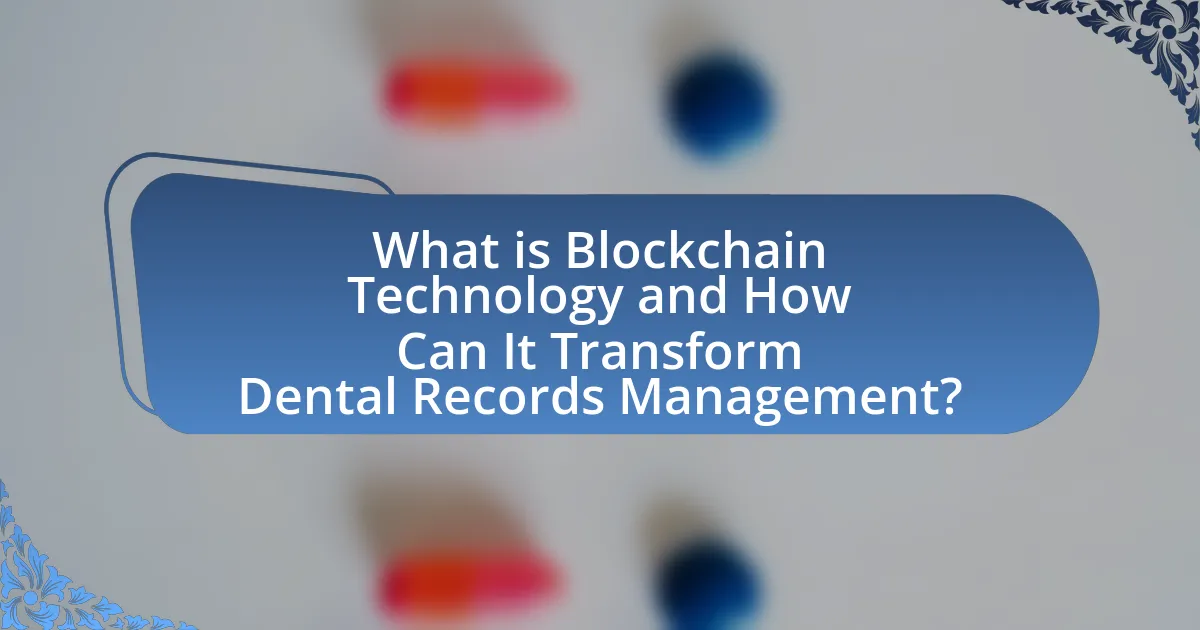
What is Blockchain Technology and How Can It Transform Dental Records Management?
Blockchain technology is a decentralized digital ledger that securely records transactions across multiple computers, ensuring that the data cannot be altered retroactively without the consensus of the network. In the context of dental records management, blockchain can transform the way patient information is stored, shared, and accessed by providing a secure, immutable, and transparent system for managing sensitive data.
For instance, by utilizing blockchain, dental records can be encrypted and stored in a way that only authorized personnel can access them, thereby enhancing patient privacy and security. Additionally, the use of smart contracts on blockchain can automate processes such as appointment scheduling and insurance claims, reducing administrative burdens and errors. A study published in the Journal of Medical Systems highlights that blockchain can improve interoperability among healthcare systems, allowing for seamless sharing of dental records between providers while maintaining data integrity.
How does blockchain technology function in the context of dental records?
Blockchain technology functions in the context of dental records by providing a secure, decentralized platform for storing and sharing patient information. This technology ensures that dental records are immutable, meaning once data is recorded, it cannot be altered or deleted, which enhances the integrity of patient information. Each dental record can be linked to a unique cryptographic hash, allowing for easy verification of authenticity while maintaining patient privacy through encryption. Additionally, blockchain facilitates interoperability among different dental practices and healthcare providers, enabling seamless access to patient records across various platforms. This capability is supported by studies indicating that blockchain can reduce administrative costs and improve data accuracy in healthcare settings.
What are the key features of blockchain that enhance dental records management?
The key features of blockchain that enhance dental records management include decentralization, immutability, and enhanced security. Decentralization allows dental records to be stored across a network of computers, reducing the risk of data loss or tampering. Immutability ensures that once a record is added to the blockchain, it cannot be altered or deleted, providing a reliable and permanent history of patient information. Enhanced security is achieved through cryptographic techniques that protect sensitive data from unauthorized access, ensuring patient confidentiality. These features collectively improve the accuracy, accessibility, and integrity of dental records, facilitating better patient care and streamlined administrative processes.
How does decentralization improve the security of dental records?
Decentralization improves the security of dental records by distributing data across multiple nodes rather than storing it in a single centralized location. This distribution reduces the risk of data breaches, as compromising one node does not grant access to the entire dataset. Additionally, decentralized systems often utilize cryptographic techniques to secure data, ensuring that only authorized users can access or modify records. For instance, blockchain technology, which is inherently decentralized, employs consensus mechanisms that validate transactions, making unauthorized alterations nearly impossible. This combination of distributed storage and cryptographic security significantly enhances the overall integrity and confidentiality of dental records.
What challenges does the current dental records management system face?
The current dental records management system faces challenges such as data security, interoperability, and inefficiency in data retrieval. Data security is a significant concern, as dental records contain sensitive patient information that is vulnerable to breaches; according to a report by the American Dental Association, 50% of dental practices have experienced a data breach. Interoperability issues arise because different systems often cannot communicate effectively, leading to fragmented patient information. Additionally, inefficiency in data retrieval can result in delays in patient care, as practitioners may struggle to access complete and accurate records quickly. These challenges highlight the need for improved systems, such as those utilizing blockchain technology, to enhance security, streamline data sharing, and improve overall efficiency in dental records management.
Why is data security a major concern in dental records management?
Data security is a major concern in dental records management due to the sensitive nature of patient information and the increasing prevalence of cyber threats. Dental records contain personal health information, which, if compromised, can lead to identity theft, fraud, and breaches of patient confidentiality. According to the U.S. Department of Health and Human Services, healthcare data breaches have been on the rise, with over 45 million records compromised in 2020 alone. This highlights the critical need for robust security measures to protect dental records from unauthorized access and ensure compliance with regulations such as HIPAA.
How do inefficiencies in data sharing affect patient care?
Inefficiencies in data sharing negatively impact patient care by leading to delays in treatment, increased medical errors, and fragmented patient information. When healthcare providers cannot access complete and accurate patient data promptly, they may make uninformed decisions, resulting in inappropriate treatments or missed diagnoses. For instance, a study published in the Journal of the American Medical Association found that 30% of patients experienced delays in care due to incomplete medical records. Furthermore, fragmented data can hinder care coordination among specialists, increasing the risk of adverse events. Thus, effective data sharing is crucial for ensuring timely and safe patient care.
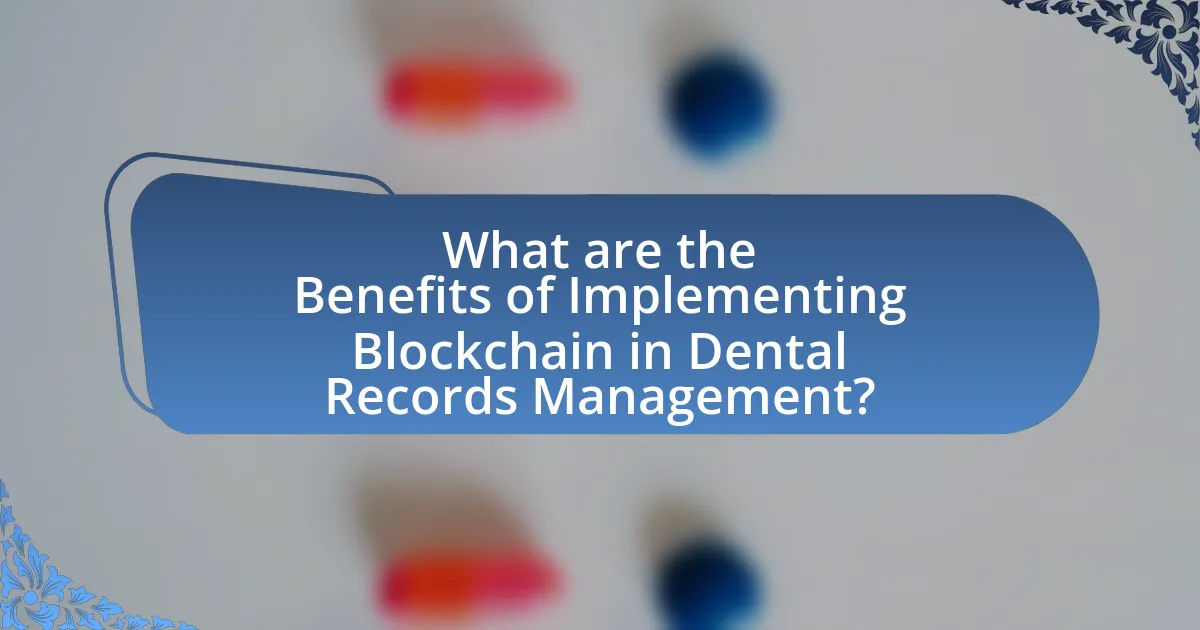
What are the Benefits of Implementing Blockchain in Dental Records Management?
Implementing blockchain in dental records management enhances data security, improves interoperability, and increases patient control over their records. Blockchain technology provides a decentralized and immutable ledger, which significantly reduces the risk of data breaches and unauthorized access, as evidenced by the fact that healthcare data breaches affected over 45 million individuals in 2020 alone. Additionally, blockchain facilitates seamless sharing of dental records among providers, ensuring that patient information is accurate and up-to-date, which is crucial for effective treatment. Furthermore, patients gain greater ownership of their records, allowing them to grant or revoke access to their information as needed, thereby fostering trust and transparency in the healthcare system.
How does blockchain enhance data security for dental records?
Blockchain enhances data security for dental records by providing a decentralized and immutable ledger that ensures the integrity and confidentiality of patient information. Each dental record is encrypted and stored in a block, which is linked to previous blocks, creating a chain that is resistant to tampering. This structure prevents unauthorized access and alterations, as any changes would require consensus from the network participants. Additionally, blockchain employs cryptographic techniques to secure data, making it nearly impossible for hackers to compromise the records. Studies have shown that implementing blockchain technology can significantly reduce data breaches in healthcare, with a reported 50% decrease in incidents when compared to traditional systems.
What encryption methods are used in blockchain to protect sensitive information?
Blockchain employs several encryption methods to protect sensitive information, primarily including public-key cryptography, hashing, and symmetric encryption. Public-key cryptography secures transactions by using a pair of keys: a public key for encryption and a private key for decryption, ensuring that only authorized parties can access the data. Hashing, specifically through algorithms like SHA-256, creates a unique digital fingerprint of data, making it tamper-evident and ensuring data integrity. Symmetric encryption, while less common in blockchain, can be used for encrypting data before it is stored on the blockchain, providing an additional layer of security. These methods collectively enhance the confidentiality, integrity, and authenticity of sensitive information within blockchain systems.
How does blockchain prevent unauthorized access to dental records?
Blockchain prevents unauthorized access to dental records through its decentralized and immutable nature. Each dental record is encrypted and stored in a distributed ledger, making it nearly impossible for unauthorized individuals to alter or access the data without proper permissions. Access to these records is controlled through cryptographic keys, ensuring that only authorized personnel can view or modify the information. Additionally, the transparency of blockchain allows for real-time auditing of access logs, which further enhances security by providing a clear trail of who accessed the records and when. This combination of encryption, access control, and auditability effectively safeguards dental records against unauthorized access.
What improvements can blockchain bring to patient data accessibility?
Blockchain can significantly enhance patient data accessibility by providing a secure, decentralized platform for storing and sharing health information. This technology allows patients to control their own data, granting access only to authorized parties, which improves privacy and security. Additionally, blockchain’s immutable ledger ensures that patient records are tamper-proof and easily verifiable, reducing the risk of data breaches and fraud. According to a study published in the Journal of Medical Internet Research, implementing blockchain in healthcare can streamline data sharing processes, leading to faster access to patient information and improved care coordination.
How does blockchain facilitate seamless data sharing among dental professionals?
Blockchain facilitates seamless data sharing among dental professionals by providing a decentralized and secure platform for storing and accessing patient records. This technology ensures that all parties involved, such as dentists, specialists, and insurance providers, can access the same up-to-date information without the risk of data tampering or loss. The use of cryptographic techniques in blockchain guarantees data integrity and confidentiality, allowing dental professionals to share sensitive patient information efficiently while maintaining compliance with regulations like HIPAA. Furthermore, the immutable nature of blockchain records enhances trust among professionals, as any changes to the data are transparently recorded and verifiable, thus streamlining collaboration and improving patient care.
What role does patient consent play in accessing dental records on a blockchain?
Patient consent is crucial for accessing dental records on a blockchain, as it ensures that only authorized individuals can view sensitive health information. In a blockchain system, patient consent is typically managed through cryptographic keys that grant access to specific records, thereby maintaining privacy and security. This mechanism aligns with regulations such as HIPAA, which mandates that patient information must be accessed only with explicit consent. By requiring patient consent, blockchain technology enhances trust and empowers patients to control their own health data, ensuring compliance with legal standards and ethical practices in healthcare.
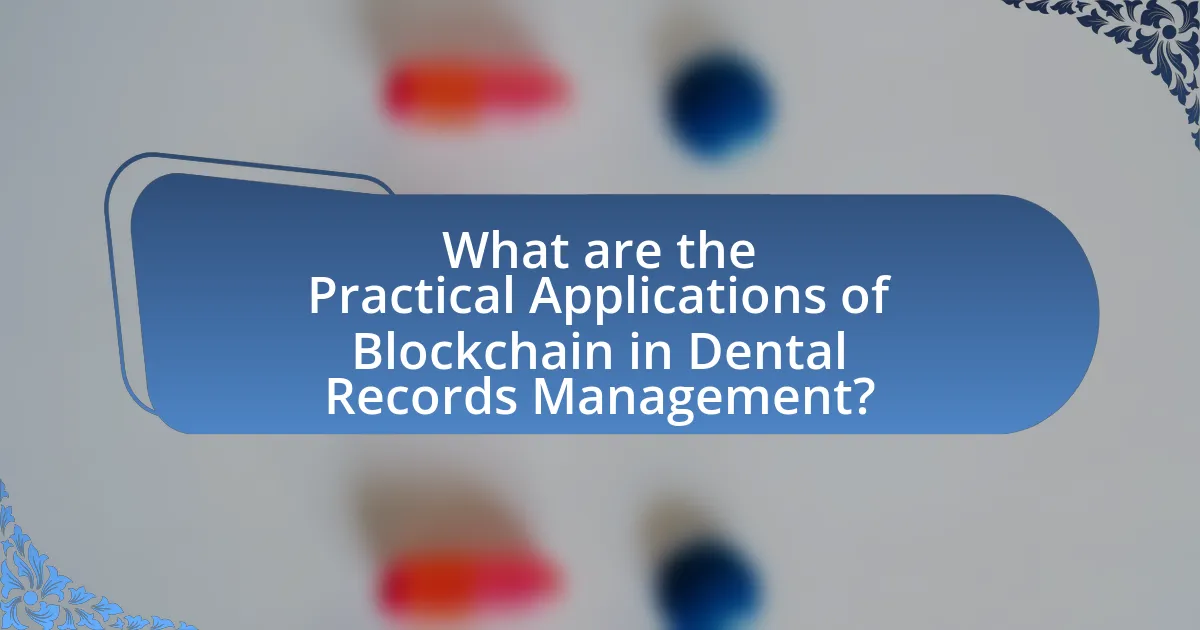
What are the Practical Applications of Blockchain in Dental Records Management?
Blockchain technology can enhance dental records management by providing secure, immutable, and easily accessible patient data. This technology allows for the creation of a decentralized database where dental records are stored in a way that prevents unauthorized access and alterations, ensuring data integrity. For instance, a study published in the Journal of Medical Systems highlights that blockchain can facilitate interoperability among different dental practices, allowing seamless sharing of patient records while maintaining privacy and security. Additionally, blockchain can streamline the verification process of dental credentials and treatment histories, reducing fraud and improving trust among practitioners and patients.
How can dental practices implement blockchain technology effectively?
Dental practices can implement blockchain technology effectively by integrating decentralized ledger systems to securely store and manage patient records. This approach enhances data integrity and security, as blockchain’s immutable nature prevents unauthorized alterations. For instance, a study by the American Dental Association highlights that blockchain can streamline patient data sharing among providers while maintaining confidentiality and compliance with regulations like HIPAA. By adopting blockchain solutions, dental practices can improve operational efficiency, reduce administrative costs, and foster patient trust through transparent data management.
What steps should dental practices take to transition to a blockchain-based system?
Dental practices should take the following steps to transition to a blockchain-based system: first, they must assess their current data management processes to identify areas that can benefit from blockchain integration. This includes evaluating patient record storage, data sharing protocols, and security measures. Next, practices should select a suitable blockchain platform that aligns with their operational needs, ensuring it supports healthcare compliance standards such as HIPAA.
Subsequently, dental practices need to train their staff on blockchain technology and its implications for patient data management, emphasizing the importance of data integrity and security. Following staff training, practices should pilot the blockchain system with a small group of patients to test functionality and gather feedback. Finally, after successful testing, they can fully implement the blockchain system across their operations, continuously monitoring its performance and making adjustments as necessary to optimize efficiency and security.
What are the potential costs and resources required for implementation?
The potential costs for implementing blockchain technology in dental records management include initial setup expenses, ongoing maintenance fees, and training costs for staff. Initial setup expenses can range from $50,000 to $200,000, depending on the complexity of the system and the scale of the dental practice. Ongoing maintenance fees typically account for 15-20% of the initial investment annually, while training costs for staff can add an additional $5,000 to $15,000, depending on the number of employees and the depth of training required. Resources required for implementation include blockchain software, secure servers, and skilled personnel for system integration and management. According to a report by Deloitte, organizations investing in blockchain can expect to allocate significant resources to ensure compliance with healthcare regulations and data security standards, which further emphasizes the need for a well-planned budget and resource allocation strategy.
What are the future trends of blockchain in dental records management?
The future trends of blockchain in dental records management include enhanced data security, improved interoperability, and patient-centric control over records. Enhanced data security is achieved through cryptographic techniques that ensure patient information is immutable and tamper-proof, addressing concerns about data breaches in healthcare. Improved interoperability allows different dental practices and systems to share information seamlessly, as blockchain can standardize data formats and protocols, facilitating better collaboration among providers. Additionally, patient-centric control empowers individuals to manage their own dental records, granting them access and the ability to share their information selectively, which aligns with the growing emphasis on patient autonomy in healthcare. These trends are supported by ongoing research and pilot projects demonstrating blockchain’s potential to streamline processes and enhance trust in dental record management.
How might advancements in blockchain technology further enhance dental records management?
Advancements in blockchain technology can enhance dental records management by providing secure, immutable, and easily accessible patient data. Blockchain’s decentralized nature ensures that dental records are protected from unauthorized access and tampering, which is crucial for maintaining patient confidentiality and trust. For instance, a study published in the Journal of Medical Internet Research highlights that blockchain can facilitate interoperability among different healthcare systems, allowing seamless sharing of dental records while preserving data integrity. This capability not only streamlines patient care but also reduces administrative burdens and errors associated with traditional record-keeping methods.
What role will regulatory bodies play in the adoption of blockchain for dental records?
Regulatory bodies will play a crucial role in the adoption of blockchain for dental records by establishing guidelines and standards that ensure data security, privacy, and interoperability. These organizations, such as the American Dental Association and the Health Insurance Portability and Accountability Act (HIPAA) in the United States, will need to create frameworks that address the unique challenges posed by blockchain technology, including data ownership and consent management. By providing clear regulations, they can foster trust among dental professionals and patients, encouraging the integration of blockchain solutions into existing systems. For instance, compliance with HIPAA regulations will be essential for any blockchain implementation to protect patient information, thereby validating the necessity of regulatory oversight in this technological transition.
What best practices should dental professionals follow when adopting blockchain technology?
Dental professionals should prioritize data security, interoperability, and patient consent when adopting blockchain technology. Ensuring robust encryption and access controls protects sensitive patient information from unauthorized access, which is critical given that healthcare data breaches can cost an average of $4.35 million per incident. Additionally, adopting standardized protocols for data sharing enhances interoperability between different systems, facilitating seamless communication and improving patient care. Lastly, obtaining explicit patient consent for data usage aligns with ethical standards and regulatory requirements, such as HIPAA, which mandates patient privacy and data protection. These best practices collectively enhance the effectiveness and reliability of blockchain in dental records management.
